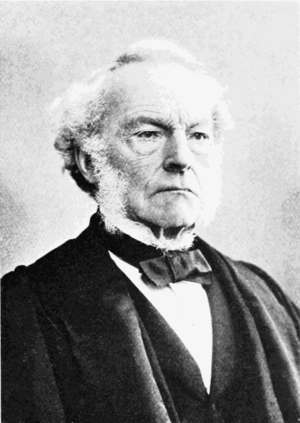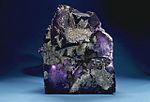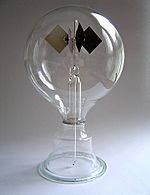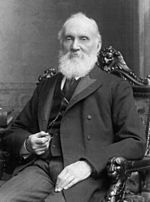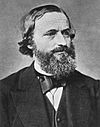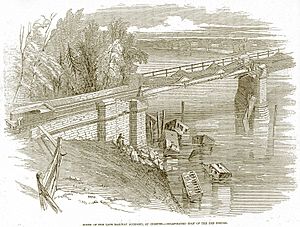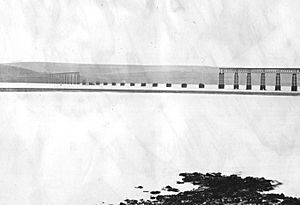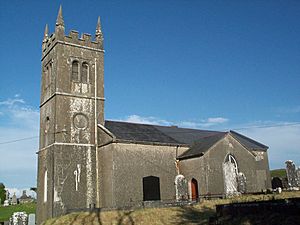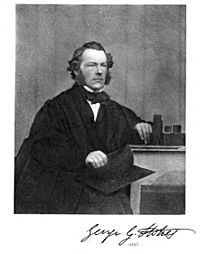Sir George Stokes, 1st Baronet facts for kids
Quick facts for kids
George Stokes
|
|
|---|---|
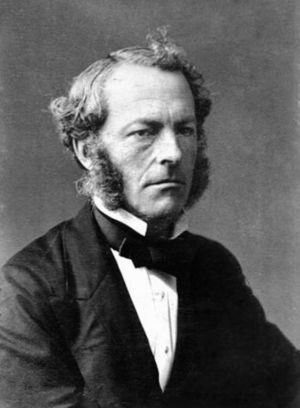 |
|
| Born |
George Gabriel Stokes
13 August 1819 Skreen, County Sligo, Ireland
|
| Died | 1 February 1903 (aged 83) Cambridge, England
|
| Alma mater | Pembroke College, Cambridge |
| Known for | Stokes' theorem Navier–Stokes equations Stokes' law Stokes's law of sound attenuation Stokes shift Stokes number Stokes problem Stokes relations Stokes phenomenon Stokes parameters Stokes wave |
| Awards | Smith's Prize (1841) Rumford Medal (1852) Actonian Prize (1886) Copley Medal (1893) |
| Scientific career | |
| Fields | Mathematics and physics |
| Institutions | Pembroke College, Cambridge |
| Academic advisors | William Hopkins |
| Notable students | Lord Rayleigh Horace Lamb |
| Signature | |
Sir George Gabriel Stokes (born August 13, 1819 – died February 1, 1903) was a brilliant Irish physicist and mathematician. He was born in County Sligo, Ireland. Stokes spent his entire career at the University of Cambridge. There, he held the important title of Lucasian Professor of Mathematics from 1849 until he passed away in 1903.
As a physicist, Stokes made huge discoveries in how fluids move, which is called fluid mechanics. This included his work on the Navier–Stokes equations. He also made big steps in understanding light, especially about how light waves are arranged (called polarization) and how some materials glow (called fluorescence).
As a mathematician, he helped make "Stokes' theorem" popular. This theorem is a key idea in vector calculus, a type of math used to describe things that have both direction and size. He also helped develop the theory of asymptotic expansions, which are ways to approximate complex math problems. Stokes also worked with another scientist, Felix Hoppe-Seyler. Together, they showed how haemoglobin in blood carries oxygen. They also showed how the color of blood changes when it gets oxygen.
Stokes was honored by the British monarch in 1889, becoming a baronet. In 1893, he received the Copley Medal from the Royal Society. This was the most important science award in the world at that time. He got it for his "researches and discoveries in physical science." He also represented Cambridge University in the British Parliament from 1887 to 1892. He was a member of the Conservative Party. Stokes was also the president of the Royal Society from 1885 to 1890. For a short time, he was even the head of Pembroke College, Cambridge.
Biography
George Stokes was the youngest son of Reverend Gabriel Stokes. His father was a clergyman in the Church of Ireland in Skreen, County Sligo. George's home life was very religious, influenced by his father's strong Protestant beliefs. Three of his brothers became church ministers. His brother John was especially close to George. George lived with John while he went to school in Dublin. He was also very close to his sister Elizabeth.
After going to schools in Skreen, Dublin, and Bristol, Stokes started at Pembroke College, Cambridge in 1837. Four years later, in 1841, he graduated as the best math student, known as the senior wrangler. He also won the first Smith's prize. These achievements helped him become a fellow of the college.
When Stokes married Mary Susanna Robinson in 1857, he had to leave his fellowship. This was because of the college rules at the time. However, twelve years later, new rules allowed him to be re-elected as a fellow. He kept this position until 1902. The day before his 83rd birthday, he was chosen to be the head of Pembroke College. Stokes did not hold this job for long. He passed away in Cambridge on February 1, 1903. He was buried in the Mill Road cemetery. There is also a special memorial for him in Westminster Abbey.
Career Highlights
In 1849, Stokes was given the important job of Lucasian Professor of Mathematics at Cambridge. He held this position for a very long time, until his death in 1903. This was 54 years, the longest anyone has held that title! In 1899, people celebrated his 50 years in this role. Many representatives from universities in Europe and America came. Stokes received a special gold medal. Marble statues of him were also given to Pembroke College and the university.
Stokes became a baronet in 1889. He also served his university by representing it in the British Parliament from 1887 to 1892. He was one of two members for the Cambridge University area. From 1885 to 1890, he was also the president of the Royal Society. He had been one of its secretaries since 1854. Stokes was the first person to hold all three of these important positions at the same time. Isaac Newton also held these three roles, but not all at once.
Stokes was one of three great scientists who made Cambridge famous for mathematical physics in the mid-1800s. The other two were James Clerk Maxwell and Lord Kelvin. Stokes started his original scientific work around 1840. He published over a hundred papers by 1883. Some were short notes, but many were long and detailed studies.
Stokes' Scientific Discoveries
Stokes' work covered many areas of physics. As scientist Marie Alfred Cornu noted, most of his work was about waves. He studied how waves change as they travel through different materials.
Fluid Dynamics
Stokes' first published papers in 1842 and 1843 were about how fluids move steadily. In 1845, he wrote about the friction of moving fluids. In 1850, he studied how the internal friction of fluids affects pendulums. He also helped us understand sound. For example, he explained how wind affects sound and how the type of gas changes sound intensity.
These studies helped create the modern science of fluid dynamics. His work explained many natural things, like why clouds stay in the air. It also showed why ripples and waves in water eventually disappear. His research also helped solve practical problems, such as how water flows in rivers and how much resistance ships face in water.
Stokes' Law and Creeping Flow
Stokes' work on fluid motion and how thick or sticky a fluid is (called viscosity) led to his famous "Stokes' law." This law helps calculate how fast a sphere falls through a thick liquid. He figured out the friction force (also called drag force) on round objects moving very slowly through a fluid.
His work is the basis for the falling sphere viscometer. This device measures how thick a liquid is. In this experiment, a liquid is placed in a vertical glass tube. A sphere (like a small ball bearing) of a known size and weight is dropped into the liquid. If chosen correctly, the sphere will reach a steady speed, called terminal velocity. You can measure this speed by timing how long it takes to pass two marks on the tube. Knowing the sphere's speed, size, and weight, and the liquid's weight, Stokes' law helps calculate the liquid's viscosity. This method is used in schools with glycerine and in factories to check the thickness of liquids.
This same idea explains why tiny water droplets or ice crystals can float in the air as clouds. They only fall as rain or snow when they grow big enough. The CGS unit for kinematic viscosity is even named "stokes" to honor his work.
Light Discoveries
Stokes' most famous research is probably about the wave theory of light. He started his work on optics early in his career. In 1845 and 1846, he published papers on how light seems to shift when observed from a moving source (called aberration of light). In 1848, he wrote about patterns seen in the electromagnetic spectrum.
In 1849, he published a long paper on the theory of diffraction. This is when light waves bend around obstacles. He showed that the way light waves are arranged (their polarization) must be straight up and down to the direction the light is moving. Two years later, he studied the colors seen in thick plates.
Stokes also looked at George Airy's math for rainbows. Airy's math was hard to solve. Stokes found a clever way to simplify it by using a "divergent series." By ignoring most of the terms in the series, Stokes found a very accurate way to estimate the answer. This was much easier than solving the original math problem. Stokes' research on these series led to important new ideas about them.
Fluorescence
In 1852, Stokes wrote a famous paper about how light changes its wavelength. In this paper, he described fluorescence. He saw this in materials like fluorspar and uranium glass. He realized these materials could change invisible ultra-violet radiation into longer, visible light waves. The "Stokes shift", which describes this change, is named after him. He even showed a model to explain how this works. This discovery also led to the idea of "Stokes line", which is important in Raman scattering.
Polarization of Light
In 1852, Stokes also published a paper about how different sources of polarized light combine. In 1853, he studied how some non-metallic materials reflect light like metals. This research helped us understand the phenomenon of light polarisation. Around 1860, he studied how much light is reflected or passed through a stack of plates. In 1862, he wrote a valuable report for the British Association on double refraction. This is when certain crystals, like Iceland spar (a clear calcite crystal), show different ways of bending light depending on the direction.
He also wrote about the long spectrum of electric light and later studied how blood absorbs light (its absorption spectrum).
Ophthalmology
In 1849, Stokes invented the Stokes lens. This special lens helps doctors find astigmatism, a common eye problem where vision is blurry. It's made of two lenses with equal but opposite power. They can be rotated to help correct vision.
Other Scientific Work
Stokes also worked on other areas of physics. He studied how heat moves through crystals in 1851. He also looked into Crookes radiometers, which are devices that spin when exposed to light. In 1882, he explained why photographs sometimes show a bright edge around dark objects against the sky. Later, he developed a theory about x-rays. He thought they might be transverse waves traveling as many single waves, not in regular patterns.
He also wrote important math papers in 1849 about gravity and how it changes on Earth's surface (this led to Stokes' gravity formula). He also worked on math problems related to how railway bridges might break. This research was important for his advice to a special commission after the Dee Bridge disaster in 1847.
Unpublished Discoveries
Many of Stokes' discoveries were never fully published. Some were only mentioned in his lectures. One example is his work on the theory of spectroscopy.
In 1871, Lord Kelvin said that Stokes had taught him about using light to study the chemicals in the sun and stars before 1852. Kelvin said Stokes had explained the basic ideas of spectroscopy to him. This suggests that Stokes understood the main ideas of spectroscopy years before Kirchhoff published his famous work.
However, Stokes himself later said he missed one key step. He didn't realize that if something gives off light of a certain color, it must also absorb light of that same color. He humbly said he didn't deserve credit for "Kirchhoff's admirable discovery." But many English scientists still believe Stokes was the first to state the basic rules of spectroscopy.
Stokes also greatly helped other scientists. As Lucasian Professor, he offered to help anyone at the university with their math problems. Many students and even other professors came to him for help. For thirty years, he was also the secretary of the Royal Society. In this role, he had a huge impact on science. He not only did his own research but also suggested problems for others to study. He was always ready to encourage and help.
Contributions to Engineering
Stokes was involved in several investigations into railway accidents. He was part of a special commission after the Dee Bridge disaster in May 1847. This commission looked into using cast iron in railway structures. Stokes helped calculate the forces that moving trains put on bridges. The Dee Bridge failed because a cast iron beam was used to support the trains. Cast iron is weak when pulled or bent. Many other similar bridges had to be taken down or made stronger.
He also gave expert advice during the investigation of the Tay Bridge disaster. He explained how wind forces affected the bridge. The middle part of the bridge was completely destroyed during a storm in 1879. An express train was on the bridge at the time, and everyone on board died. The investigation concluded that the bridge was "badly designed, badly built and badly maintained."
Because of his advice, Stokes was made a member of another special commission. This one studied how wind pressure affects large structures. At that time, people didn't fully understand the effects of strong winds. The commission took many measurements across Britain to learn about wind speeds during storms and the pressure they put on buildings.
Work on Religion
Stokes held traditional religious beliefs. In 1886, he became president of the Victoria Institute. This group was created to defend Christian beliefs against new scientific ideas, especially Darwin's theory of evolution. In 1891, he gave the Gifford lecture on natural theology, which explores God through nature. He was also a vice-president of the British and Foreign Bible Society. He was active in discussions about missionary work. While his religious views were mostly traditional, he did not believe in eternal punishment in hell. Instead, he supported the idea of Conditionalism, which means that people only live forever if they are saved.
As President of the Victoria Institute, Stokes wrote that both science and religion come from God. He believed there should be no real conflict between them if understood correctly. He said that if there seems to be a disagreement, we should not favor one over the other. He felt that even if we are sure about our religious beliefs, we might be wrong about how we understand them. And even if scientific evidence seems strong, it's only probable, and more knowledge might change our minds.
Personal Life
On July 4, 1857, George Stokes married Mary Susanna Robinson at St Patrick's Cathedral, Armagh. She was the daughter of the astronomer Reverend Thomas Romney Robinson. They had five children. Their son, Arthur Romney, inherited his father's title. Two daughters, Susanna Elizabeth and Dora Susanna, died when they were babies. Their daughter Isabella Lucy wrote a personal story about her father in a book. Their son, Dr. William George Gabriel, was a doctor who sadly died at age 30. Stokes' family line through his sons eventually ended.
Legacy and Honors
- He was the Lucasian Professor of Mathematics at Cambridge University for 54 years.
- The Royal Society made him a fellow in 1851. He received the Rumford Medal in 1852 for his work on light waves. Later, in 1893, he received the Copley Medal, their highest award.
- In 1869, he led the British Association meeting in Exeter.
- From 1883 to 1885, he gave lectures at Aberdeen. These lectures, published later, were about the nature of light, how it helps us investigate things, and its good effects.
- On April 18, 1888, he was made a Freeman of the City of London.
- On July 6, 1889, Queen Victoria made him a Baronet as Sir George Gabriel Stokes. This title ended in 1916.
- In 1891, he published a book on Natural Theology as part of his Gifford lectures.
- He was a member of the Prussian Order Pour le Mérite, a high honor.
- He received honorary degrees from many universities, including a special math degree from the Royal Frederick University in 1902.
- The "stokes", a unit for measuring how thick a fluid is, is named after him.
- In 1909, the Stokes Society was started at Pembroke College. It's a group for science students at the university and is still active today.
- In July 2017, Dublin City University named a building after Stokes to recognize his contributions to physics and mathematics.
See also
 In Spanish: George Gabriel Stokes para niños
In Spanish: George Gabriel Stokes para niños
- Stokes flow


